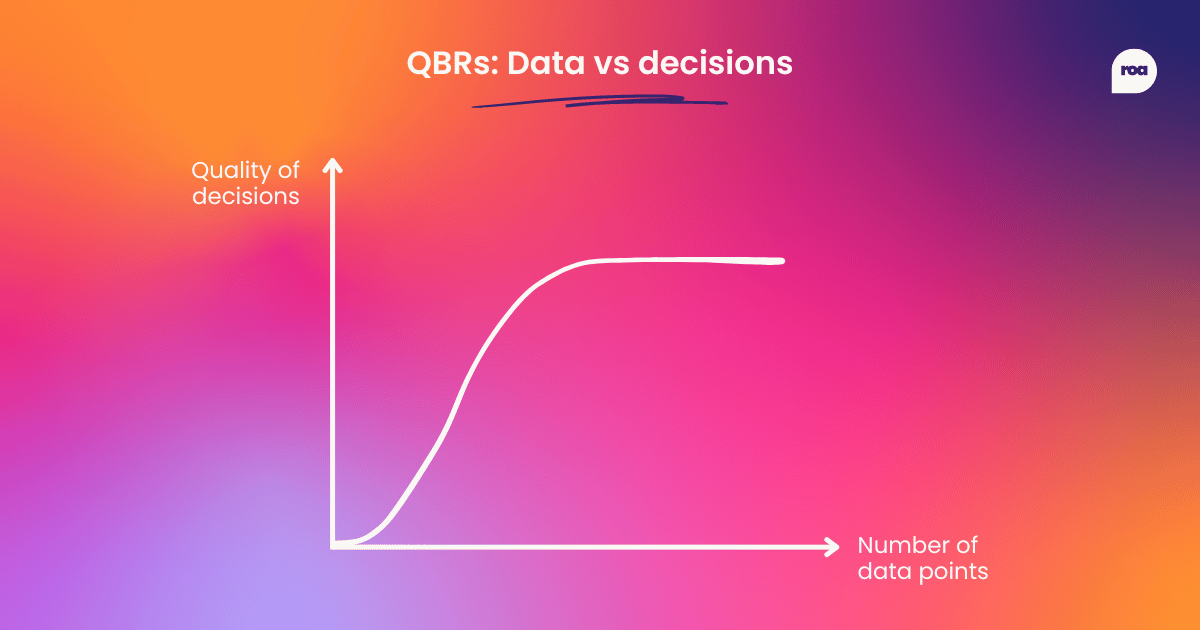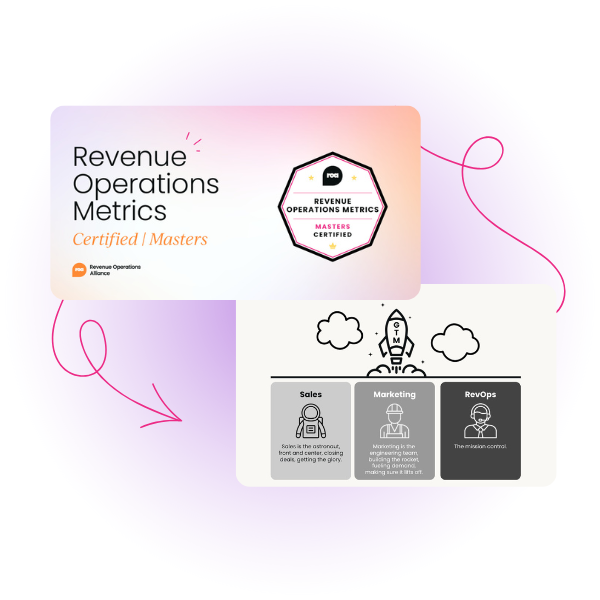Quarterly Business Reviews (QBRs) are vital checkpoints for organizations, particularly for revenue operations (RevOps) leaders who act as the connective tissue between sales, marketing, customer success, and finance.
Done right, QBRs not only serve as a performance evaluation for the past quarter but also a launchpad for future strategy, alignment, and growth.
But many, including ourselves at first, fall into the trap of trying to discuss everything and anything and end up losing the storyline, debating the meaning of certain metrics and how they are measured, and getting bogged down into other details which prevent you from understanding the drivers behind performance.
Here are five tips we learned and deployed at Just Eat Takeaway.com (JET) for business to help us have meaningful and more effective QBRs:
1. Agree on the metrics and their definitions before the QBR invite even goes out.
As you manage your business have you identified and agreed on your North Star outcome and the underlying metrics and KPIs that help you drive that North Star?
At JET for business, gross merchandise volume (GMV) and revenue are, of course, indicators of our success, but our North Star is how much value the end-user gets from using our product and how repetitive their behavior is (which ultimately drives revenue).
In our case, this North Star metric is orders per user.
For your company, this can be something else. Based on that North Star, start building a KPI tree that shows how each metric is connected to each other and how it builds up to the overall department objective.
Once you have identified the different metrics, write down what each metric means and how it’s measured and calculated. Create a KPI glossary everyone can read and refer to. Now you have the basic foundation to review performance.

2. Data: Quality over Quantity
It's easy to overwhelm your QBR with endless charts, spreadsheets, and KPIs, but more data does not always lead to better decision-making.
In fact, too much information can lead to analysis paralysis, where the team becomes bogged down in numbers without deriving actionable insights.

Curate the right data points and prioritize actionable metrics
Focus on key performance indicators (KPIs) that align directly with your goals.
For example, if customer retention is a priority, focus on churn, net promoter score (NPS), and renewal rates. Avoid drowning the team in vanity metrics that look impressive but offer little actionable insight.
Use Leading and Lagging Indicators
While lagging indicators (e.g., revenue, churn, closed deals) give you a snapshot of what has already happened, it’s crucial to also focus on leading indicators (e.g., pipeline growth, website traffic, demo requests) that forecast future performance.
This balance provides both retrospective clarity and forward-looking foresight.
3. Structure your QBR around your revenue funnel and start with the end
Your QBR should have a structured agenda that balances looking back at the past quarter's performance and planning actionable steps for the next quarter. Without a well-defined structure, your session risks becoming unfocused and ineffective.
Here at JET for business we start with the end of our bowtie and work our way back to dig deeper and deeper to uncover the drivers all the way back to how our campaigns or sales initiatives performed.
The structure we use is:
- Overall performance to see what has been our GMV or revenue number. This includes: how many users we have, what their usage was, and how our top accounts evolved this quarter vs. the previous quarter.
- How well did we close deals?
- Then we look at our pipeline to understand how well we manage our opportunities.
- Lastly, how well did we manage to generate leads and create interest?

For each of these four sections, we dig deeper into each. For example, are we creating opportunities at a constant rate, what’s the size of these opportunities, and is that growing? We might also look at the main reasons for losing certain opportunities and discuss lessons can we draw from underperforming deals.
By looking at the entire revenue funnel (or bowtie) every team’s contribution (or lack thereof) becomes clear and can be discussed.
A QBR is about engaging in meaningful discussions that drive alignment and growth. Therefore, it’s important to encourage open dialogue during the meeting and create space for feedback, questions, and suggestions from the entire revenue or GTM team.
This will show dependencies and create shared accountability over the goal and past performance. (And allows for celebration where appropriate!)
Sufficient time needs to be carved out to look ahead effectively. Outline the key strategic initiatives for the upcoming quarters. This could include new product launches, entering new markets, or improving cross-sell/upsell strategies. But also discuss budget allocations, headcount planning, and technological investments. Ensure these decisions align with the goals set for the next quarter.
4. Structure the meeting around key themes
A well-organized QBR has specific sections dedicated to high-priority areas. This prevents the session from becoming an unstructured discussion. Here’s a suggested structure:
Key objectives
Start by setting the tone of the meeting.
Outline the key objectives of the review and the desired outcomes. This primes everyone to stay focused and goal-oriented. Keep time to ensure the conversations does not derail and all topics get covered sufficiently.
Executive summary
Provide a top-down summary of the previous quarter’s performance. Cover key metrics but avoid going into granular detail.
This executive summary is the so-what of the QBR and should offer a broad understanding of the quarter’s success or challenges.
At JET for business we use a simple framework around what went well, what could be improved and what are the next steps for next quarter, to summarize the entire quarter. This makes it easier to digest and remember when covering multiple regions.
Sales, customer success, and marketing performance
Next, you can dive deep into sales performance, including pipeline coverage, deal velocity, win rates, and sales productivity. Cross-reference these metrics with revenue targets and other financial KPIs.
Then, review customer success metrics such as churn, top account evolution, and upsell opportunities. Tie these back to revenue retention, and customer adoption and expansion goals.
Examine marketing's contribution to pipeline growth and closed deals. Assess campaign effectiveness, lead generation, and lead-to-opportunity conversion rates.
Based on the lessons learned, what changes need to happen to meet next quarter's goals?

5. Drive accountability with ownership and action items
One of the common pitfalls of QBRs is that they can become a retrospective exercise without clear action steps for the future. Make sure every section of the meeting leads to actionable insights, with clearly assigned owners for follow-up tasks.
To ensure accountability:
- Assign specific owners: Every action item should have a clearly designated owner. This ensures that tasks don’t fall through the cracks and there’s clear accountability for next quarter’s success.
- Set deadlines: For each action item, set a concrete deadline. This keeps initiatives on track and aligns everyone around the same timelines.
- Track progress: Use regular check-ins (e.g., monthly updates or mid-quarter reviews) to track progress on the action items agreed upon during the QBR. This keeps everyone aligned and helps course-correct if necessary.
In closing: Put the Q of Quality in your QBR
QBRs are pivotal for RevOps leaders to maintain alignment, adjust strategies, and drive growth.
By focusing on a clear agenda, curating the right data points, structuring your meeting thoughtfully, highlighting both risks and opportunities, assigning actionable items, you’ll transform your QBRs into powerful tools for steering the company toward future success.
Remember: more data doesn’t equal better decisions. Quality insights, focused discussions, and actionable outcomes are the key to a successful QBR.
Unlock RevOps metrics mastery.
Take your revenue operations metrics game to the next level with our expert-led certification. And gain the necessary knowledge to measure your RevOps impact with confidence.



 6 min read
6 min read
 Follow us on LinkedIn
Follow us on LinkedIn





